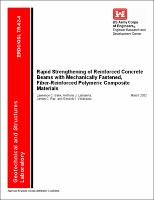Please use this identifier to cite or link to this item:
https://hdl.handle.net/11681/10536| Title: | Rapid strengthening of reinforced concrete beams with mechnically fastened, fiber-reinforced polymeric composite materials |
| Authors: | University of Wisconsin--Madison. Department of Civil and Environmental Engineering Bank, Lawrence C. Lamanna, Anthony J. Ray, James C. Velázquez, Gerardo I. |
| Keywords: | Beam retrofit Bridge retrofit Beam upgrade Bridge upgrade Fiber reinforced polymetric FRP plates FRP Mechanical fasteners Fibrous composites Polymeric composites Concrete beams |
| Publisher: | Geotechnical and Structures Laboratory (U.S.) Engineer Research and Development Center (U.S.) |
| Series/Report no.: | ERDC/GSL TR ; 02-4. |
| Description: | Technical Report Abstract: The U.S. military must often deploy to other countries where bridges may have insufficient strength for their heavy tactical vehicles. In recent years, fiber-reinforced polymeric (FRP) materials have emerged as a viable retrofit scheme for strengthening reinforced concrete bridges. However, because of stringent application requirements, long cure times, and climatic sensitivity, this technology has yet to prove feasible for military operations where time is often the most critical factor. Furthermore, Army operations are conducted under the broadest range of climatic conditions. For these reasons, the U.S. Army Engineer Research and Development Center has undertaken to develop a unique FRP application methodology utilizing powder-actuated mechanical fasteners (i.e., nails from a conventional carpenter s nail gun). This method shows great promise for military applications, since no substrate preparation or adhesive curing is required. Additionally, this method should work well in all but the most extreme environments. For this purpose, numerous laboratory tests have been conducted, and the results have been very promising. This report provides a detailed summary of the first 2 years of testing on this concept. |
| Rights: | Approved for public release; distribution is unlimited. |
| URI: | http://hdl.handle.net/11681/10536 |
| Appears in Collections: | Technical Report |
